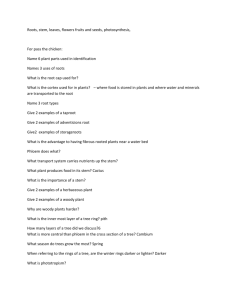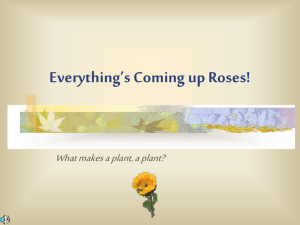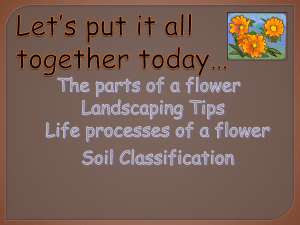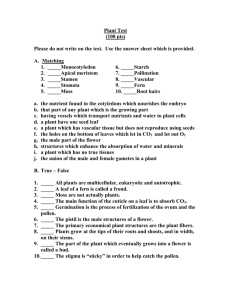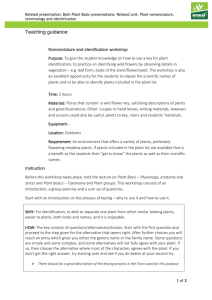basicbotany_tanner
advertisement
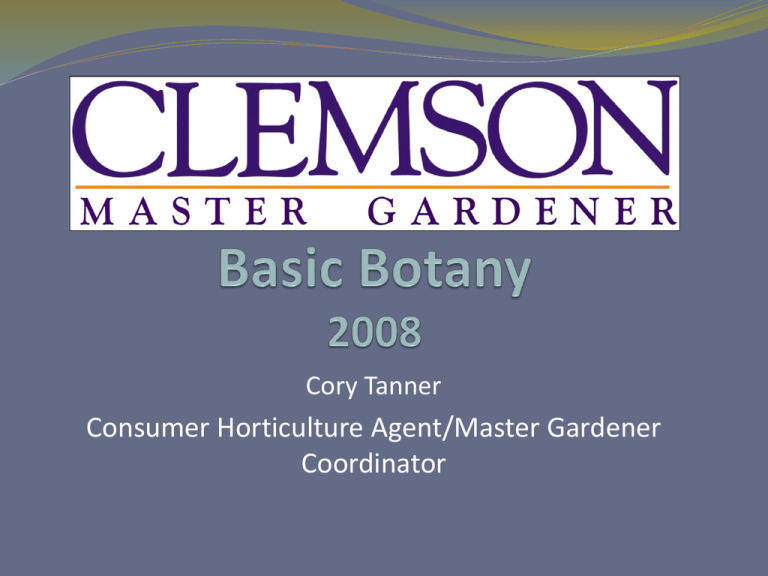
Cory Tanner Consumer Horticulture Agent/Master Gardener Coordinator Terminology Botany: the science of plants Anatomy: internal structure Morphology: external structure/form Taxonomy: the classification of plants Physiology: study of plant growth and development Vascular Plants Ferns Cone Bearing Plants Flowering Plants Dicots Monocots Terminology Gymnosperm – “naked seed” Has no flower or ovary (fruit); only cones All conifers (pines, cedars, arborvitae) Angiosperm – “vessel seeded” Has a flower with an ovary (fruit) All flowering plants Divided into Monocots and Dicots Terminology Dicotyledons (Dicots): - flowering plants that contain two seed leaves Monocotyledons (Monocots): - flowering plants that possess one seed leaf Monocot Dicot Plant Parts Plant parts fall into two categories: a) vegetative b) sexual reproductive Meristems Apical Meristems (aka Terminal Buds) • Found at shoot and root tips • Produce stems, roots, leaves, and lateral buds • Responsible for shoot/root length (Primary Growth) Lateral Meristems (aka Cambium) • Located laterally along stems and roots • Responsible for increases in stem/root girth (Secondary Growth) Vascular Tissues Xylem – transports water and mineral nutrients from roots to stems and leaves. Phloem – transports sugars (photosynthates) from leaves to other plant parts. Can move “sap” up or down. Xylem and phloem arranged in vascular bundles. Roots Functions of Roots: 1. absorption (water and mineral) 2. structural support 3. storage Types of Roots: 1. radicle – seed root 2. primary root – tap root 3. lateral root Root Anatomy Above Ground * * * * * * Stem Parts Stem Anatomy Tree Trunk Components Types of Buds Vine Morphology Leaf Parts blade midrib petiole Leaf Anatomy Leaf Arrangement Leaf Types Leaf Venation • Venation refers to the pattern in which the veins are distributed in the leaf blade • Parallel or Net-veined • Net-veined can be either pinnate or palmate Flower Anatomy • Sepals - small, green, leaf-like structures on the base of the flower • Petals - highly colored parts of the flower • Stamen - male reproductive parts • Pistil - female reproductive parts Flower Anatomy • Perfect flower - has a stamen, pistil, petal and sepals. • Incomplete flower - missing one of the four parts • Complete flower - has a stamen and pistil • Imperfect flower - has either stamen (staminate) or a pistil (pistillate) Flower Anatomy • Dioecious - have staminate (male) and pistillate (female) on separate plants i.e., hollies. • Monoecious - have male and female flowers on the same plant i.e., squash and cucumbers. Inflorescences: flower arrangements Pollination Cross-pollination - pollen from one plant is transferred to the stigma of another. Self-pollination - the stigma is pollinated by pollen from the same plant. Fertilization - ovule (egg) is fertilized by the sperm from the pollen grain. Fruit An enlarged ovary. -Simple -Aggregate -Multiple Seed A mature ovule, that contains the embryo and cotyledons (starch filled food source). Growth Cycles Annual: A plant that completes its lifecycle in one growing season. Winter annuals survive the winter, summer annuals survive the summer. Biennial: A plant the requires two growing seasons to complete its lifecycle. Herbaceous perennial: A non-woody plant that lives for several years. It’s shoots die back every winter. Woody perennial: A tree or shrub
